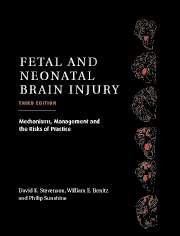Book contents
- Frontmatter
- Contents
- List of contributors
- Foreword
- Preface
- Part I Epidemiology, Pathophysiology, and Pathogenesis of Fetal and Neonatal Brain Injury
- Part II Pregnancy, Labor, and Delivery Complications Causing Brain Injury
- Part III Diagnosis of the Infant with Asphyxia
- 20 Clinical manifestations of hypoxic–ischemic encephalopathy
- 21 The use of the EEG in assessing acute and chronic brain damage in the newborn
- 22 Structural and functional imaging of hypoxic–ischemic injury (HII) in the fetal and neonatal brain
- 23 Near-infrared spectroscopy and imaging
- 24 Placental pathology and the etiology of fetal and neonatal brain injury
- 25 Correlations of clinical, laboratory, imaging and placental findings as to the timing of asphyxial events
- Part IV Specific Conditions Associated with Fetal and Neonatal Brain Injury
- Part V Management of the Depressed or Neurologically Dysfunctional Neonate
- Part VI Assessing the Outcome of the Asphyxiated Infant
- Index
- Plate section
22 - Structural and functional imaging of hypoxic–ischemic injury (HII) in the fetal and neonatal brain
from Part III - Diagnosis of the Infant with Asphyxia
Published online by Cambridge University Press: 10 November 2010
- Frontmatter
- Contents
- List of contributors
- Foreword
- Preface
- Part I Epidemiology, Pathophysiology, and Pathogenesis of Fetal and Neonatal Brain Injury
- Part II Pregnancy, Labor, and Delivery Complications Causing Brain Injury
- Part III Diagnosis of the Infant with Asphyxia
- 20 Clinical manifestations of hypoxic–ischemic encephalopathy
- 21 The use of the EEG in assessing acute and chronic brain damage in the newborn
- 22 Structural and functional imaging of hypoxic–ischemic injury (HII) in the fetal and neonatal brain
- 23 Near-infrared spectroscopy and imaging
- 24 Placental pathology and the etiology of fetal and neonatal brain injury
- 25 Correlations of clinical, laboratory, imaging and placental findings as to the timing of asphyxial events
- Part IV Specific Conditions Associated with Fetal and Neonatal Brain Injury
- Part V Management of the Depressed or Neurologically Dysfunctional Neonate
- Part VI Assessing the Outcome of the Asphyxiated Infant
- Index
- Plate section
Summary
Introduction
In the twenty-first century neonatal neuroimaging will be classified as either “structural,” that is, based on anatomic or morphologic data, or “functional,” in which images will be generated based upon physiologic or metabolic data. Currently the major structural imaging modalities are ultrasound (US), computed tomography (CT), and magnetic resonance imaging (MRI). These are commonly used to screen for anatomic abnormalities associated with neonatal intracranial hemorrhage (ICH) and ischemia associated with hypoxic-ischemic injury (HII). While US, CT, and MRI are technologically mature, few studies address the issue of which imaging protocols are most appropriate for the diagnosis of neonatal ICH and ischemia. US, the most commonly employed imaging modality in neonates, is less sensitive and less specific for the detection of intracranial ischemia and hemorrhage compared with CT or MRI. It is unclear, however, if the greater expense and logistical difficulties in obtaining CT and MRI examinations in critically ill neonates are justified. Furthermore, the lack of white-matter myelinization and patterns of ischemic and hemorrhagic lesions are markedly different in premature infants as compared to term which complicates the interpretation of CT or MRI examinations. The predictive value and clinical utility of US, CT, or MRI in neonates with HII have also been the subject of a number of longitudinal studies. However, it is difficult from any of these investigations to distill out a uniform set of imaging protocols for the screening and management of neonates with HII and, more importantly, individual prognostication.
- Type
- Chapter
- Information
- Fetal and Neonatal Brain InjuryMechanisms, Management and the Risks of Practice, pp. 446 - 489Publisher: Cambridge University PressPrint publication year: 2003
- 1
- Cited by



